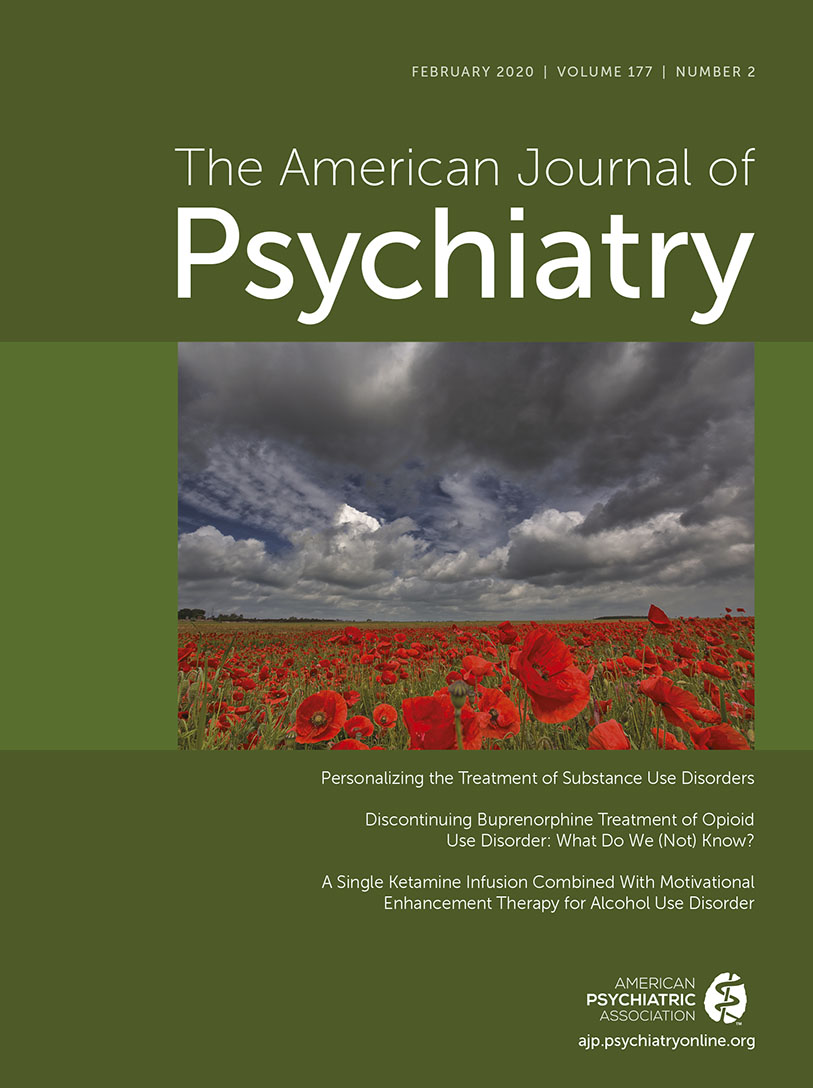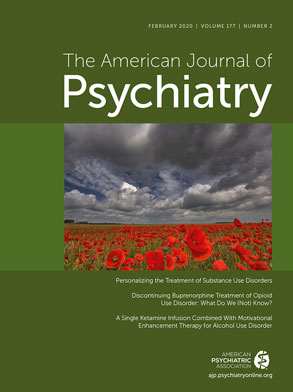Problematic alcohol use and its sequelae are major causes of medical morbidity worldwide and leading contributors to excess mortality. Globally, the estimated 12-month and lifetime adult prevalence rates of alcohol use disorder are 8.5% and 20%, respectively, with even higher rates in the United States. Remarkably few individuals receive any treatment for alcohol use disorder, and even fewer receive evidence-based psychotherapeutic or pharmacological treatment (
1).
Several medications with evidence of benefit for alcohol use disorder, including acamprosate and topiramate, broadly target glutamate homeostasis. However, the improvements in short-term outcomes (such as returning to any drinking and number of drinking days) are modest (
1). Over the long-term, nonadherence and lack of engagement in treatment are common, resulting in repeated cycles of relapse and treatment recidivism. Innovative approaches to enhance an individual’s engagement in treatment and motivation to abstain are thus essential to discover.
In this issue of the
Journal, Dakwar and colleagues (
2) report findings from a pilot clinical trial of a single intravenous ketamine infusion combined with motivational enhancement therapy for individuals with alcohol dependence. Ketamine, an
N-methyl-
d-aspartate glutamate receptor (NMDA-R) antagonist, has long been used as an anesthetic and analgesic. Over the past decade, ketamine has been increasingly prescribed off-label as a rapid-acting antidepressant (its
S-enantiomer received regulatory approval in the United States in 2019 as an adjunctive therapy for treatment-resistant depression) (
3). Dakwar’s team has been at the forefront of investigating ketamine’s potential therapeutic application to substance use disorders. In the human laboratory setting, they previously reported that single infusions of ketamine exerted a rapid but transient beneficial effect on cocaine use, motivation to quit, and craving (
4,
5). When a single ketamine infusion was administered to treatment-seeking individuals with cocaine dependence in conjunction with a mindfulness-based relapse prevention program, the salutary effects on abstinence were notably persistent, supporting the viability of an integrated pharmacological plus behavioral platform (
6).
This new report by Dakwar and colleagues on individuals with alcohol dependence (
2) adopted a similar strategy by pairing ketamine with motivational enhancement therapy, hypothesizing that the combination would act synergistically to initiate and sustain abstinence. In the trial, 40 treatment-seeking adults with alcohol dependence (averaging five drinks per day) were randomly assigned to either a single 52-minute subanesthetic dose infusion of ketamine or the benzodiazepine midazolam, used as an active control. The infusion was performed on a designated quit day during the second week of the 5-week motivational enhancement therapy program and occurred at least 24 hours after the last reported use of alcohol during a period of required abstinence. Motivational enhancement therapy is a manualized behavioral treatment used in previous large trials and focuses on promoting motivation and self-directed change. Although motivational enhancement therapy is considered a gold-standard behavioral treatment for addictions, by itself, weekly sessions have only shown modest efficacy for promoting abstinence. For this trial, an additional session occurred 24 hours following the study infusion “to capitalize on the hypothesized motivation-enhancing effects of ketamine, which may be most pronounced within the 24–48 hour postinfusion period” (
2).
As hypothesized, individuals randomly assigned to a single ketamine infusion showed an increased likelihood of abstinence over the 21-day period following the infusion. The effects of ketamine on abstinence were robust, with a modeled number needed to treat of 4. Secondary outcomes favoring the ketamine group over the midazolam group included a reduced likelihood of heavy drinking days (17.6% compared with 40.9%), as well as a longer time to relapse (defined as the first heavy drinking day or dropout). There were no between-group differences in craving or withdrawal, nor in behavioral measures of stress sensitivity and self-efficacy. The ketamine infusion was generally well tolerated and was associated with expected transient side effects, such as dissociation. Supporting the view that ketamine can bolster treatment engagement, no patient in the ketamine group dropped out of the 5-week motivational enhancement therapy trial. It is also noteworthy that, in spite of recruiting from a population of patients with active and significant substance use history (a group that has routinely been excluded from ketamine trials in depression), no participant showed evidence of new drug-seeking behaviors, helping to allay an important concern given ketamine’s abuse potential.
Overall, these findings are provocative and hypothesis-generating but certainly not definitive because of the small sample size. Another important limitation was the brief follow-up period and high post-motivational enhancement therapy attrition rate—approximately half the participants could not be contacted for a telephone interview at the 6-month follow-up. Finally, it is important to note that participants did not have comorbid medical or psychiatric illnesses nor additional substance use disorders, limiting generalizability.
Biological mechanisms underlying the persistence of the effects of ketamine were not explored in this study and remain an area of focused investigation (
7). The authors posit several neurobiological hypotheses extensively explored with respect to ketamine’s rapid antidepressant effects, including enhancement of neurotrophic mechanisms and changes in prefrontal functional connectivity affecting glutamatergic, opioid, and dopaminergic signaling. Could ketamine simply function as a replacement for alcohol itself, akin to an agonist model of addiction treatment? Ethanol is an allosteric modulator of NMDA-R activity and acts to reduce NMDA-R function (
8). Dakwar and colleagues reasonably contend that ketamine’s sustained impact on drinking behaviors, lasting well beyond the metabolic clearance of ketamine and its metabolites, argues against an agonist model as an explanatory framework.
What are potential next steps for this line of research? Most importantly, this preliminary work requires replication in larger samples followed over a longer period, utilizing appropriate controls. Because participants in both arms received motivational enhancement therapy, the study is unable to distinguish a stand-alone effect of ketamine from a truly synergistic biological-behavioral effect. These study design limitations also extend to initial reports of the efficacy of drugs such as psilocybin for alcohol dependence when dosed in conjunction with motivational enhancement therapy (
9).
This study also suggests new directions for ketamine research more generally across psychiatric conditions. The design of ongoing large clinical trials of intravenous ketamine for treatment-resistant depression (
10) and posttraumatic stress disorder (PTSD) (
11) requires use of repeated infusions of ketamine (2–3 doses weekly for 3–4 weeks), predicated on the assumption that repeated, intermittent ketamine dosing is essential for optimal short-term benefit and prevention of relapse. Could fewer ketamine (or esketamine) treatment sessions be equally or more effective when combined with behavioral approaches designed to exploit ketamine’s acute (e.g., synaptogenic, motivation-enhancing) effects as a window of opportunity in which to introduce enduring, adaptive learning?
This hypothesis is consistent with broader calls to develop novel interventions that rationally wed the acute, rapid impact of pharmacological or somatic (e.g., neuromodulatory) interventions with behavioral procedures, based on posited complimentary mechanisms (
12). Preliminary evidence suggests that ketamine infusion followed immediately by behavioral intervention could potentially produce enduring benefit across a range of disorders (e.g., depression [
13], PTSD [
14], obsessive-compulsive disorder [
15], cocaine dependence [
6], and now alcohol dependence). Within this approach, rapid-acting pharmacology represents merely the first step in a novel treatment algorithm designed to foster relief that is both rapid and durable, by leveraging learning-based mechanisms. To date, these studies have used small samples and have routinely lacked crucial experimental controls (e.g., each intervention component in the absence of the other) (
12). This methodological limitation is applicable to the study by Dakwar and colleagues, in which participants in both arms received motivational enhancement therapy, precluding the ability to distinguish a stand-alone effect of ketamine from a truly synergistic biological-behavioral effect. Thorough tests of hypothesized synergy in larger samples are ongoing (e.g., clinicaltrials.gov NCT03237286: (“Testing a synergistic, neuroplasticity-based intervention for depressive neurocognition”)) and remain an important goal for future research across a range of psychiatric conditions.
The authors are appropriately circumspect about the immediate clinical implications of this small pilot study. A potential clinical issue concerns the advisability of coadministration of naltrexone and ketamine. Naltrexone, an opioid antagonist with the highest affinity for the mu opioid receptor, is a Food and Drug Administration-approved medication for alcohol use disorder. A recent study reported that a single 50-mg dose administration of naltrexone dramatically blocked the rapid antidepressant and antisuicidal effects of intravenous ketamine (
16), though there is also contradictory evidence for the effect of naltrexone injection on individuals with depression and alcohol use disorder receiving serial ketamine infusions (
17).
The much larger clinical challenge is the massive underutilization of any evidence-based pharmacotherapy treatment for alcohol use disorder. These new data affirm the potential of rational combinatorial approaches for a vexing medical and public health problem.

